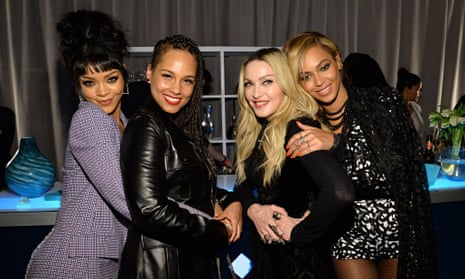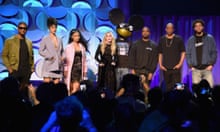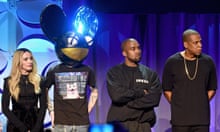What is Tidal and why should music fans care?
Tidal is a music streaming service that originally started in Scandinavia in 2009. It was called WiMP then, launched by technology firm Aspiro and retailer Platekompaniet – Norway’s equivalent of HMV. In October 2014 Aspiro rebranded WiMP as Tidal for its UK and US launch, with its main selling-point being its “lossless” (higher-quality) streams. It also added music videos and deeper editorial, albeit for double the price – £19.99 a month – of rivals such as Spotify, although it has now launched a non-lossless £9.99 version too. Aspiro had 500,000 paying subscribers at the end of 2014, and was bought for $56m last month by a company controlled by Jay Z.
Why are so many famous names involved?
Tidal is under new ownership, and those owners are musicians. Not just Jay Z, but Arcade Fire, Beyoncé, Calvin Harris, Coldplay, Daft Punk, Deadmau5, Jack White, Jason Aldean, J Cole, Kanye West, Madonna, Nicki Minaj, Rihanna and Usher. All appeared at the company’s press conference on Tuesday, and all have equity in Tidal too. The company is pitching itself as “the first artist-owned global music and entertainment platform”, and promising to give shares to other musicians too. It has yet to confirm whether labels will also get stakes in Tidal, as they have with Spotify, or whether it plans to raise money from venture capital investors.
Why do these artists want to own a streaming service?
The big message from Tidal’s launch was its new owners’ determination to restore the value of music in the eyes (or ears) of listeners, which means making them pay for it, rather than listening for free, as they can on the advertising-supported tiers of rivals Spotify and Deezer. “People are not respecting the music, and [are] devaluing it and devaluing what it really means. People really feel like music is free, but will pay $6 for water,” said Jay Z in an interview with trade magazine Billboard. He’s not alone. Taylor Swift pulled her music from Spotify in 2014 in protest at that company’s unwillingness to let her remove it from its free tier, while this year Lucian Grainge – boss of major label Universal Music – has talked publicly about his concerns over free streaming.
What’s wrong with free streaming?
As the biggest streaming music service, Spotify is most under the cosh in this debate. The company is under pressure to introduce more restrictions on its free tier – for example, withholding the latest albums – or even do away with it entirely. Yet Spotify argues that its free tier is crucial in persuading people to buy a monthly subscription. It has 60 million users, and 15 million of them pay for it. “Our free service drives our paid service. Here’s the key fact: more than 80% of our subscribers started out as free users,” wrote chief executive Daniel Ek last year. No subscription-only service has come close to matching Spotify’s total of 15 million paying users. The nearest so far is Rhapsody (which operates as Napster outside the US): it clocked up 2.5 million subscribers in February.
Can Tidal really pay more to artists?
One of the big talking points around music streaming is how much – or how little – artists and songwriters make from it. Tidal is claiming it will pay more, but that may not be as easy as it hopes. Streaming companies do not pay musicians directly; they pay record labels and music publishers, which then pass on whatever percentage of that money each creator’s contract entitles them to. There are two ways musicians can earn more from streaming. The first is organic growth: the more people use these services, the more streams there will be and so the eventual royalty cheques will be bigger. The second is for artists to get a bigger share of the money paid to their labels, with contracts ranging from fair to awful on this front. Tidal cannot control the terms of those deals any more than its rivals can. Or can it?
Will big stars have the clout to secure transparency?
The main gripe about Tidal under Jay Z is that it is a bunch of rich artists trying to get richer. But one of the strongest arguments in favour of its starry ownership is that they may have the clout to make music royalties more transparent for all artists. If Kanye West, Madonna and the rest are serious in their commitment to shining a light on how the money paid by streaming companies – not just in royalties but in advance payments to major labels for the rights to their catalogues – gets distributed to musicians, that could answer the doubters. “We’re saying that we’re in a position to bring light to this issue. We’re using our power that way,” Jay Z told an audience of music students in New York .
How will Tidal compete with established rivals?
One of Tidal’s key tactics for standing out from the streaming crowd will be exclusives: the promise that you will be able to hear some music on Tidal before it is available anywhere else. This is a game being played by Spotify too, though, as well as Apple, which is preparing to relaunch its US-only Beats Music streaming service globally later this year. Both are courting big artists for exclusive deals, so Tidal will have to persuade musicians’ labels – including those of its owners – that it is worth alienating Spotify and Apple to get early access to new music. The bigger risk is alienating fans. If albums are exclusively on Tidal or Spotify or iTunes a week before their official release, that is one thing. If these exclusives last for months and/or extend to artists’ entire catalogues, expect fan unrest, even though this is the accepted model for TV streaming services such as Netflix.
Will Apple be the king of the streaming world?
Apple’s Beats relaunch is expected to be announced in June and is likely to stick with a subscription-only model, although the company is likely to make a free trial available to its hundreds of millions of iPhone and iPad users. Behind the scenes, Apple has been lobbying labels to allow it to undercut rivals with a £7.99 monthly subscription, although recent reports suggested it had been refused. It is also building a team of curators to refine its service and recommend music to users, among them former Radio 1 DJ Zane Lowe and Trent Reznor of Nine Inch Nails. Apple’s service will be a fearsome competitor, particularly given the company’s willingness to disrupt rivals however it can. For example, behind the scenes, its executives have been encouraging anti-free sentiments within the music industry.
What about YouTube and Google?
YouTube is the world’s most popular music streaming service, with a large chunk of its 1 billion monthly viewers watching music videos – especially younger users. It is trying to get people to pay for music too: it’s launching its own Spotify rival, YouTube Music Key, with a similar model of a free, ad-supported tier then a £9.99 monthly subscription with more features. But YouTube is already a free way to listen to almost any song ever recorded. Some in the music industry fear that if Spotify’s free tier is restricted or even shut down, listeners will drift away to YouTube – which pays much less per stream – rather than subscription services.
Is this all about the big guns?
Google v Apple v Spotify v Tidal v Deezer… but there’s another trend worth watching, which is the growth of fan-funding and direct sales sites, such as Bandcamp and Patreon, for independent musicians. Bandcamp helps artists sell their own music and pays out $3.5m a month to its network of musicians. With Patreon, fans commit to paying a small amount whenever an artist releases something new: it pays out $2m a month. If Tidal represents big artists seeking more control of digital music, these sites fulfil a similar role for independent musicians. Better partnerships with them may even be the way for Tidal, Spotify and other streaming services to show themselves as truly artist-friendly.





Comments (…)
Sign in or create your Guardian account to join the discussion